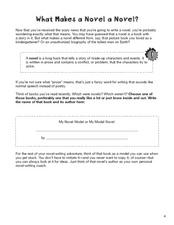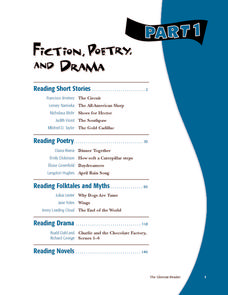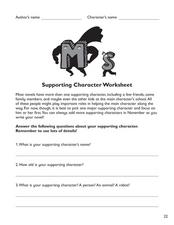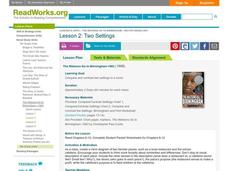Curated OER
What Makes a Novel a Novel?
As your authors prepare to write a hypothetical novel, they need all the inspiration they can find! Using a book they have already read (and enjoyed), learners complete a literary analysis by filling in eight short-answer questions....
Curated OER
Let's Write a Collaborative Novel!
Find out what it would be like for your class to write and publish a complete novel.
Curated OER
Frankenstein
Frankenstein by Mary Shelley is an interesting novel for students to explore. This comprehensive packet enables students to use critical thinking skills to evaluate what they read.
Curated OER
Julie of the Wolves
Learners reading the book Julie of the Wolves by Jean Craighead George can enhance their understanding of the novel using this comprehensive activity. Students can use the graphic organizers to display information and the many...
Curated OER
Fiction, Poetry, and Drama Part 1
Similar to a textbook, this resource includes multiple texts, plenty of explanation, lots of practice, and several graphic organizers. Use all of the materials, or pick and choose from such texts as "The Circuit," "Shoes for Hector,"...
Curated OER
Kumeyaay Indians
Useful for literary analysis, citing textual evidence, or summary skills, this lesson about the Kumeyaay Indians would be a good addition to your language arts class. Middle schoolers read novels and summarize the literature in their own...
Curated OER
Body Biography: The Lion, the Witch and the Wardrobe
Class groups assume the identity of one of the primary human characters in The Lion, the Witch and the Wardrobe. They create a body biography that identifies the most important traits of their character, translate these traits into...
Curated OER
What Makes a Novel a Novel?
They always say to write what you know. This approach is used to get middle schoolers prepared to write novels of their own. Using a favorite book as a model, potential novelists respond to prompts that ask about characters, plot, main...
Curated OER
Reading a Classic Novel
Charles Dickens offers an excellent example of sensory writing in this reading comprehension worksheet. Learners read excerpts from the novel Hard Times in which he describes the New England industrial city of Coketown. They consider why...
Curated OER
Creating Interesting Characters
What makes a story interesting? Complex characters! As part of a series of worksheets that prepares middle schoolers to write their own novel, the exercises included explain the role of the protagonist, the antagonist, and the supporting...
Curated OER
Supporting Character Worksheet
Where would Harry Potter be without Ron Weasley? Where would Holmes be without Watson? Where would a good narrative be without an interesting supporting character? Encourage character analysis with this resource, which includes six...
Curated OER
Unleash Your Inner Editor
NaNoWriMo, or National Novel Writing Month, is a writing project for which participants write an entire novel in a single month. If you have decided to this in your class, this resource will be useful for you. This is an editing...
Curated OER
Literature Soundtracks
Mix music into your literature class! After reading a novel (either in class or as outside reading), your mix masters create a soundtrack of 10 songs to accompany their reading. What does each song add to the story? A fun activity for all!
Curated OER
Novel Ideas: History of the American Novel
Explore the history of the American novel in the contexts of literature and US history. How does a novel or piece of writing from a particular time showcase the mood during that historical period? After conducting research and discussing...
Curated OER
Lesson Plan 2: Good Novel, Bad Novel
What are the characteristics of a good piece of writing? What makes a story interesting? Give your pupils a chance to define the qualities of good novels and what they see as the qualities of bad novels. Class members record these...
Curated OER
Literature and Telecommunications
Students read a novel and write short journal entries about the characters, setting and interesting facts. Using email, they share their responses to the novel with other students at a different school. Student also create slide shows...
Curated OER
Two Settings
Fifth graders analyze two settings. In this compare and contrast lesson students compare and contrast the settings in The Watsons Go to Birmingham-1963 by Christopher Paul Curtis. Students find and record similarities and differences of...
Curated OER
To Kill a Mockingbird Test
In this novel test, students complete a variety of questions including true/false, short answer, fill in the blank, essay,matching and bonus questions. The cover page of the test contains a area to record the student's score.
Curated OER
Literature Circles in Action
Students form cooperative groups to read, discuss, and respond to a novel. They select a novel from offered choices or by criteria given by teacher and complete a culminating project on the novel from such choices as: creating a...
Curated OER
Roll With the Punches: Oprah's On!
Sixth graders prepare questions for an Oprah Winfrey talk show featuring the characters from Roll of Thunder, Hear My Cry, the amazing novel by Mildred D. Taylor. Selected students role-play the characters and answer questions Oprah...
Curated OER
Evaluating a Book By Its Cover
Students practice using predictive strategies before reading a book. In this literacy lesson plan, students identify the theme and characters of the novel based on the cover illustrations.
Curated OER
Comprehension
Fifth graders study comprehension. In this writing lesson, 5th graders remember what they read and write an introduction for a character from a novel just read including a good description of that character.
Curated OER
Reading Comprehension: 1984
In this reading comprehension worksheet, students answer questions based on chapters 1-12 of '1984'. Question type varies from matching, true / false, fill in the blank and multiple choice.
Curated OER
Group Journal
In this literature circle instructional activity, the student journaling in the group is provided an area to sketch scenes from a passage they've read prior to meeting with their group. Learners are also asked to provide an explanation...

























